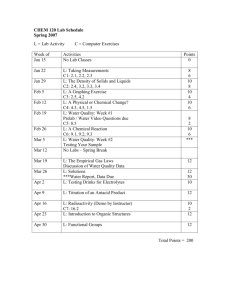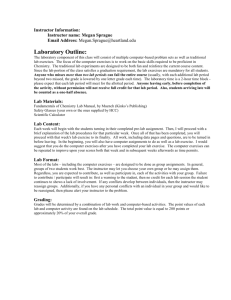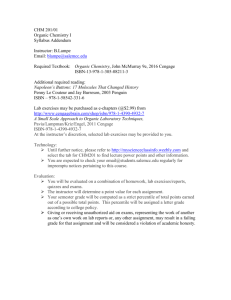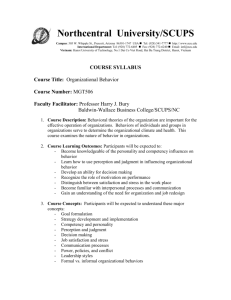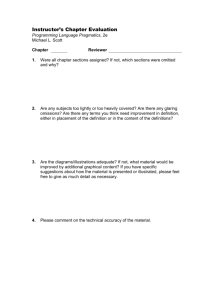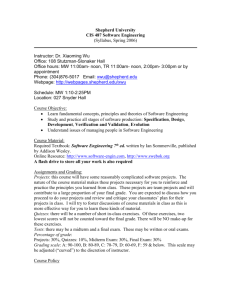BUS 319 - Introduction to Management Information Systems
advertisement
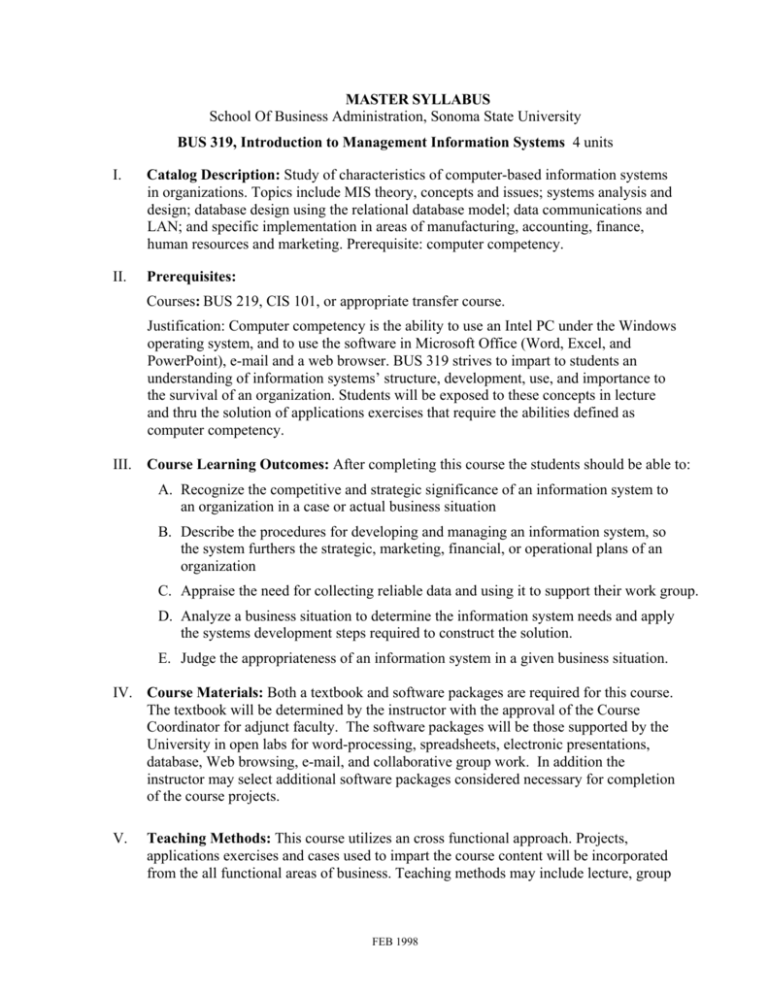
MASTER SYLLABUS School Of Business Administration, Sonoma State University BUS 319, Introduction to Management Information Systems 4 units I. Catalog Description: Study of characteristics of computer-based information systems in organizations. Topics include MIS theory, concepts and issues; systems analysis and design; database design using the relational database model; data communications and LAN; and specific implementation in areas of manufacturing, accounting, finance, human resources and marketing. Prerequisite: computer competency. II. Prerequisites: Courses: BUS 219, CIS 101, or appropriate transfer course. Justification: Computer competency is the ability to use an Intel PC under the Windows operating system, and to use the software in Microsoft Office (Word, Excel, and PowerPoint), e-mail and a web browser. BUS 319 strives to impart to students an understanding of information systems’ structure, development, use, and importance to the survival of an organization. Students will be exposed to these concepts in lecture and thru the solution of applications exercises that require the abilities defined as computer competency. III. Course Learning Outcomes: After completing this course the students should be able to: A. Recognize the competitive and strategic significance of an information system to an organization in a case or actual business situation B. Describe the procedures for developing and managing an information system, so the system furthers the strategic, marketing, financial, or operational plans of an organization C. Appraise the need for collecting reliable data and using it to support their work group. D. Analyze a business situation to determine the information system needs and apply the systems development steps required to construct the solution. E. Judge the appropriateness of an information system in a given business situation. IV. Course Materials: Both a textbook and software packages are required for this course. The textbook will be determined by the instructor with the approval of the Course Coordinator for adjunct faculty. The software packages will be those supported by the University in open labs for word-processing, spreadsheets, electronic presentations, database, Web browsing, e-mail, and collaborative group work. In addition the instructor may select additional software packages considered necessary for completion of the course projects. V. Teaching Methods: This course utilizes an cross functional approach. Projects, applications exercises and cases used to impart the course content will be incorporated from the all functional areas of business. Teaching methods may include lecture, group FEB 1998 discussion of current events, presentation and discussion of cases, applications exercises, and group projects. To provide the students with sufficient skills to develop the solutions to the application exercises, and projects and analyze information systems’ appropriateness, a minimum of one-fourth of the contact hours should be dedicated to instruction in a computer lab. Any teaching methods used in addition to the methods presented above will be determined by the instructor. VI. Evaluation Tools: This course should include sufficient computer exercises to show the development of an application for a work group or organization information system. These exercises should contain a database component, a quantitative analysis component, a network component and their integration. Any additional evaluation methods, such as quizzes or homework, will be determined by the instructor. VII. Course Content: A. Course Topics: 1. Technology concepts that provide a framework for understanding the development, management, and effective use of information and information systems in an organization a. Mainframe and personal computer hardware. b. System software for PC and mainframe computers and their relation to end user applications. c. Information and communications concepts, telecommunications hardware, software, , data communications and telecommunications models, the Internet, the Web, and intranets. Characteristics of effective information, and future trends in telecommunications. d. Database management systems concepts, development, and use. Database components, architectures, data resources, data modeling, and, data retrieval. 2. Applications of information systems in business enterprises. a. The use of information systems for business operations, including accounting, finance, marketing, manufacturing, and human resource information systems. b. The fundamentals of electronic commerce, including business to consumer, business to business, electronic data transfer, electronic payment and security. c. The use of information systems and software in enterprise collaboration and workgroup management, including intranets, externets, groupware, and conferencing. d. The use of internal and external information and models for managerial decision support, including executive information systems, expert systems, and artificial intelligence. FEB 1998 e. Strategic roles of information systems in business quality, business process reengineering, and competitive and survival issues. 3. Systems development and management concepts emphasizing the users’ role and responsibilities a. System development cycle, system analysis, system design, prototyping and information modeling tools, problem identification, requirements specifications, feasibility assessment, and user interface design b. Managing change and implementing computer and information systems in organizations c. Problems in global management of information resources, and technologies, global strategies, cultural, political and geoeconomic challenges. d. Security and ethical challenges of information technology including control issues, auditing, privacy issues, computer crime, and health issues. B. Interdisciplinary Content: Minimum Number of Class Hours Devoted to Topic International/Global Ethical Issues Political Issues Social Issues Legal/Regulatory Issues Environmental Issues Technology Issues Demographic Diversity Required Graded Work Other Than Exams? 1.5 1.5 .25 .5 .5 .25 28 .5 No No No No No No Yes No C. Interdisciplinary Skills: Required Graded Work Other Than Exams? Oral Communications Written Communications Critical Thinking Working in Teams No Yes Yes Optional FEB 1998
